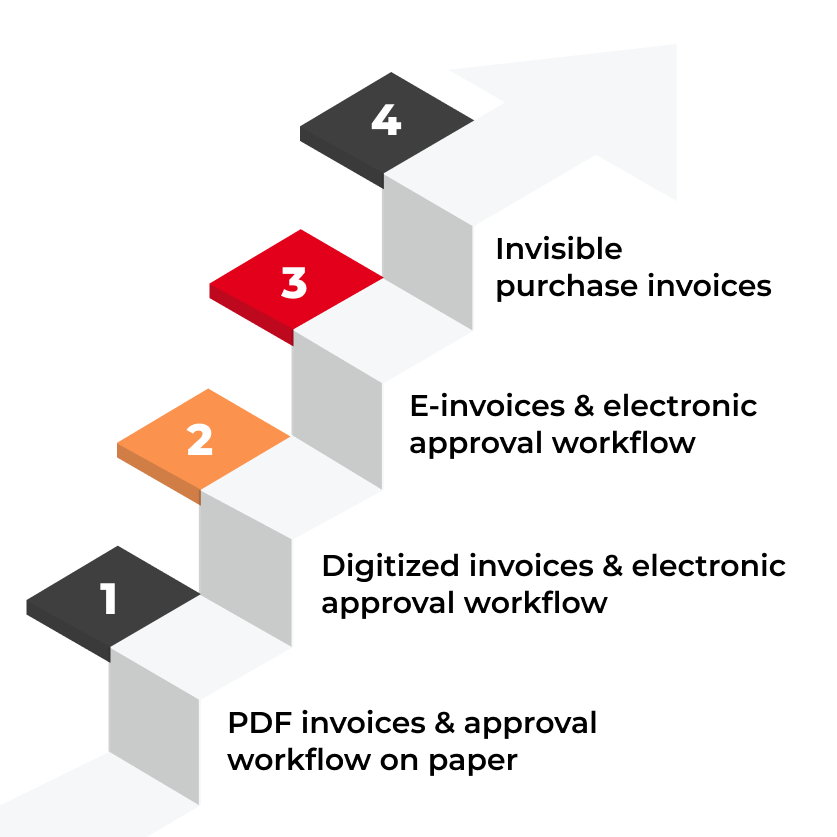When you ask ChatGPT what is real-time economy, the AI responds that as of September 2021 , the term did not yet exist. 2023. In 2023, the real-time economy is taken for granted and in the near future we will probably wonder about the tasks we had to handle manually not long ago.
Kuid alustame terminoloogiast. Real-time economy (RTE) is a digital ecosystem where transactions between different parties take place in real time or with minimal delay. This means that paper-based transactions and administrative operations are replaced with automatic data exchange in a digital, structured, machine-readable and standardized way.
In addition to production and sales, a company also has to deal with accounting and reporting workflows, which bring along a rather significant workload, since manual entry of for example PDF invoice data into the accounting system, the approval process, reporting, etc., is a labor-intensive activity.
Companies using the RTE exchange and process order, invoice and receipt data in real time. They have at all times a quick overview of their business, enabling more efficient use of resources as well as enhancing planning and risk management processes.
What is the difference between a regular order and an e-order?
If the company receives via email an order in PDF-format, which needs to be entered into the system manually, it cannot be considered an e-order. The real e-order is machine-readable, the communication between the supply chain parties takes place in real time and usually without human intervention. It clearly boosts business efficiency, helping to increase profits and turnover.
Same applies to e-invoices. Unlike paper invoices, they are machine-readable and do not require manual data entry. Since the aspect of human error is excluded, the invoices are always unambiguous, the handling process is fast and they do not get lost. There is a separate service – digitization of PDF invoices – where AI detects the necessary data on the PDF invoice and saves it in the agreed format.
E-invoices can be sent to an electronic approval workflow, which allows the approver to confirm the invoice with one click or set up automatic confirmation rules (for example, expense invoices under 50 EUR), sending accounting information directly to the ERP. Certainly, the electronic approval workflow speeds up the invoice handling process, making it smooth and saving significantly working hours. It is common knowledge that working hours have a financial dimension to them.
Purchasing maturity – what is it?
In the context of the real-time economy, we are addressing the maturity of the purchasing process. It is a 4-step ladder, where at the bottom level the entire invoicing process is manual. PDF-invoices are printed out, invoices are checked and approved on paper.
The second level is already a huge step forward. The PDF-invoice data is entered into the system by AI, and the PDF-invoice is sent to the electronic approval workflow, where confirmation activities can be automated. What does this mean for the company? Telema eFlow user statistics reveal that 92 percent of all invoices are recurring and at least one more invoice has been received from the same supplier within three months. Rising to the second level already enables the company to automate part of its invoice handling and get rid of a considerable amount of routine manual work.

The next step in the supply chain automation would be sending e-invoices to the electronic approval workflow. In such a case, the e-invoices move unchanged and without human intervention from the seller’s software to the buyer’s software.
The invoice rows are machine-readable, that data can be imported into warehouse software and used for automated accounting. In this reliable and secure solution the data cannot be misunderstood.
The last step of the ladder brings about “invisible” purchase invoices – approval is given to e-purchase order, not a purchase invoice, invoices are then automatically compared to e-purchase orders and the goods/service receipt documents. Human interaction is needed only in exceptional erroneous cases, when, for example, the price on the order does not match the price on the invoice.
Real-time economy accelerates cash flows
Real-time machine-to-machine data exchange advances communication between supply chain parties. Automatic payments accelerate cash flows, enabling more efficient operations that increase turnover and profits. It is estimated that automated e-invoice handling can save 60-80 percent of costs compared to paper invoice processing.
Besides cost reduction, e-invoicing creates new market niches for supply chain finance (SCF), mainly through the monetization of receivables and payables. The global market for SCF solutions is estimated at $1.3 trillion for receivables management, $100 billion for dynamic discounting solutions, and $340 billion for credit-backed lending.
Unfortunately, the awareness of RTE opportunities among Estonian companies is not that high. 2022. In 2022, the Ministry of Economy and Communications conducted a survey, which revealed that 55 out of 66 companies had heard of real-time economy, and 52 companies had the ability to receive and issue machine-readable documents. 11 companies had not heard of real-time economy – 5 of them with more than 250 employees and 6 companies lacked machine readability capabilities.
How to reach the real-time economy in the buying and selling processes? First of all, by mapping the current situation, choosing the appropriate tools and moving forward step by step through the described ladder levels. The toolbox already exists and includes both digitization, e-invoicing, electronic approval workflow, automated cost allocation, e-orders, automated validation and matching as well as e-archive.
The use of these tools currently presents an obvious competitive advantage, but already in the next few years they are inescapably part of every company’s business toolbox.